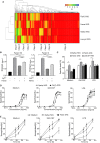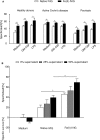Enhanced Pro-apoptotic Effects of Fe(II)-Modified IVIG on Human Neutrophils
- PMID: 32508840
- PMCID: PMC7248553
- DOI: 10.3389/fimmu.2020.00973
Enhanced Pro-apoptotic Effects of Fe(II)-Modified IVIG on Human Neutrophils
Abstract
Mild modification of intravenous immunoglobulin (IVIG) has been reported to result in enhanced polyspecificity and leveraged therapeutic effects in animal models of inflammation. Here, we observed that IVIG modification by ferrous ions, heme or low pH exposure, shifted the repertoires of specificities in different directions. Ferrous ions exposed Fe(II)-IVIG, but not heme or low pH exposed IVIG, showed increased pro-apoptotic effects on neutrophil granulocytes that relied on a FAS-dependent mechanism. These effects were also observed in human neutrophils primed by inflammatory mediators or rheumatoid arthritis joint fluid in vitro, or patient neutrophils ex vivo from acute Crohn's disease. These observations indicate that IVIG-mediated effects on cells can be enhanced by IVIG modification, yet specific modification conditions may be required to target specific molecular pathways and eventually to enhance the therapeutic potential.
Keywords: FAS; cell death; inflammation; modified IVIG; neutrophil.
Copyright © 2020 Graeter, Schneider, Verschoor, von Däniken, Seibold, Yawalkar, Villiger, Dimitrov, Smith, Cummings, Simon, Vassilev and von Gunten.
Figures




Similar articles
-
IgA Triggers Cell Death of Neutrophils When Primed by Inflammatory Mediators.J Immunol. 2020 Nov 15;205(10):2640-2648. doi: 10.4049/jimmunol.1900883. Epub 2020 Oct 2. J Immunol. 2020. PMID: 33008951
-
Intravenous immunoglobulin preparations promote apoptosis in lipopolysaccharide-stimulated neutrophils via an oxygen-dependent pathway in vitro.APMIS. 2005 Apr;113(4):269-77. doi: 10.1111/j.1600-0463.2005.apm_05.x. APMIS. 2005. PMID: 15865608
-
Intravenous immunoglobulin-induced neutrophil apoptosis in the lung during murine endotoxemia.Surg Infect (Larchmt). 2014 Feb;15(1):36-42. doi: 10.1089/sur.2012.227. Epub 2013 Oct 11. Surg Infect (Larchmt). 2014. PMID: 24116740
-
Granulocyte death mediated by specific antibodies in intravenous immunoglobulin (IVIG).Pharmacol Res. 2020 Apr;154:104168. doi: 10.1016/j.phrs.2019.02.007. Epub 2019 Feb 6. Pharmacol Res. 2020. PMID: 30738127 Review.
-
Cell death modulation by intravenous immunoglobulin.J Clin Immunol. 2010 May;30 Suppl 1:S24-30. doi: 10.1007/s10875-010-9411-8. J Clin Immunol. 2010. PMID: 20405180 Review.
Cited by
-
Ultrasound Comparative Analysis of Coronary Arteries before and after Immune Blocking Therapy with Gamma Globulin in Children with Kawasaki Disease.Evid Based Complement Alternat Med. 2022 Aug 4;2022:2900378. doi: 10.1155/2022/2900378. eCollection 2022. Evid Based Complement Alternat Med. 2022. Retraction in: Evid Based Complement Alternat Med. 2023 Jun 21;2023:9865416. doi: 10.1155/2023/9865416. PMID: 35966739 Free PMC article. Retracted.
-
The intricate relationship between autoimmunity disease and neutrophils death patterns: a love-hate story.Apoptosis. 2023 Oct;28(9-10):1259-1284. doi: 10.1007/s10495-023-01874-w. Epub 2023 Jul 24. Apoptosis. 2023. PMID: 37486407 Review.
-
Efficacy of Glucocorticoid plus Intravenous Immunoglobulin in Children with Immunoglobulin-Insensitive Kawasaki Disease.J Healthc Eng. 2022 Apr 13;2022:9011259. doi: 10.1155/2022/9011259. eCollection 2022. J Healthc Eng. 2022. Retraction in: J Healthc Eng. 2023 Sep 27;2023:9824018. doi: 10.1155/2023/9824018. PMID: 35463656 Free PMC article. Retracted.
-
Antibody diversity in IVIG: Therapeutic opportunities for novel immunotherapeutic drugs.Front Immunol. 2023 Mar 28;14:1166821. doi: 10.3389/fimmu.2023.1166821. eCollection 2023. Front Immunol. 2023. PMID: 37063852 Free PMC article. Review.
References
Publication types
MeSH terms
Substances
Grants and funding
LinkOut - more resources
Full Text Sources
Research Materials
Miscellaneous

